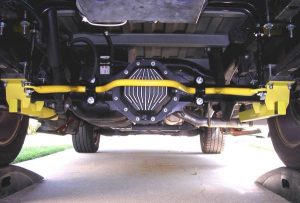When preparing a vehicle for track use, suspension tuning becomes one of the most effective ways to improve lap times, cornering stability, and driver confidence. While springs, dampers, and alignment settings play major roles, adjustable sway bars (also called anti-roll bars) offer one of the most precise and cost-effective methods for balancing a car’s handling. By modifying roll stiffness at the front and rear axles, you can tune understeer, oversteer, turn-in response, and mid-corner stability — all without sacrificing ride height or spring rates.
For high-quality components suitable for motorsport upgrades, you can Buy Stabilizer & Components online and choose parts designed for durability and precision.
Why Adjustable Sway Bars Matter in Track Tuning

Adjustable sway bars allow you to fine-tune the car’s rotational behavior during cornering by altering roll stiffness. This matters because roll stiffness defines how much weight transfers to the outside wheels, which directly affects available tire grip.
Benefits of adjustable sway bars include:
-
Fine tuning without replacing springs
-
Improved mid-corner balance
-
Adjustability for different tracks and conditions
-
Reduced body roll for faster corner entry
-
Ability to correct understeer or oversteer quickly
-
Compatibility with coilovers and performance shocks
On the track, where every small handling detail counts, this adjustability becomes invaluable.
How Sway Bars Influence Track Handling Dynamics
During hard cornering, weight shifts toward the outside tires. The sway bar resists this, but the balance between front and rear bars determines whether the car prefers to understeer or rotate more aggressively.
Front Sway Bar Effects
A stiffer front bar results in:
-
Reduced roll on the front axle
-
Faster steering response
-
Increased understeer at the limit
Rear Sway Bar Effects
A stiffer rear bar provides:
-
More rotation entering corners
-
Sharper turn-in
-
Increased risk of oversteer
Adjustment Settings and Their Effects
Most adjustable sway bars have several mounting holes or adjustable end links to change leverage. Moving the link closer to the bar’s center increases stiffness; moving it outward softens it.
Adjustment Effect Table
| Adjustment Setting | Roll Stiffness | Handling Result |
|---|---|---|
| Front Bar Stiffened | Higher front stiffness | More understeer, stable entry |
| Front Bar Softened | Lower front stiffness | More front grip, reduced understeer |
| Rear Bar Stiffened | Higher rear stiffness | More rotation, quicker turn-in |
| Rear Bar Softened | Lower rear stiffness | More rear grip, less oversteer |
These simple adjustments allow drivers to tailor handling to specific track layouts and conditions.
Tuning for Track Scenarios
1. High-Speed Tracks (fast corners)
Fast tracks require stability and minimal roll.
Recommended:
-
Medium-stiff front bar
-
Slightly stiff rear bar
-
Neutral to mild understeer for high-speed confidence
2. Technical Tracks (tight corners, hairpins)
Rotation and agility matter most.
Recommended:
-
Softer front bar
-
Stiffer rear bar
-
Increased rotation for quicker direction changes
3. Tracks with Mixed Corners
Balance becomes key.
Recommended:
-
Medium setting front
-
Medium setting rear
-
Adjust based on driver feel
Common Handling Issues and Sway Bar Solutions
| Issue | Cause | Sway Bar Adjustment |
|---|---|---|
| Excessive understeer | Front tires overloaded | Soften front or stiffen rear |
| Excessive oversteer | Rear tires lose grip | Soften rear or stiffen front |
| Slow turn-in | Too much front compliance | Stiffen front bar |
| Mid-corner instability | Imbalanced roll stiffness | Match front/rear rates more closely |
| Snap oversteer on exit | Rear stiffens too quickly | Soften rear bar |
These adjustments can often be made between track sessions, making sway bars one of the easiest tuning tools.
How to Dial In Your Adjustable Sway Bars Step by Step
1. Start with a Baseline
Use the manufacturer-recommended middle setting on both bars.
Record handling impressions during the first session.
2. Adjust One End at a Time
Changing both simultaneously makes diagnosis difficult.
3. Make Small, Incremental Changes
One hole stiffer or softer is usually enough to feel a difference.
4. Re-test Consistently
Try to:
-
Run similar lap pace
-
Use the same tire pressures
-
Maintain consistent driving line
5. Evaluate Key Behavior Points
Focus on:
-
Turn-in response
-
Mid-corner balance
-
Corner exit stability
-
Tire temperature spread
6. Match Adjustments to Driver Preference
Some drivers prefer mild oversteer to rotate the car; others want maximum stability. Adjustable sway bars let you dial this in precisely.
Complementary Upgrades for Better Sway Bar Performance
To maximize the effect of adjustable sway bars on the track, consider pairing them with:
-
Performance coilovers
-
Adjustable end links
-
Polyurethane or spherical sway bar bushings
-
Corner balancing
-
Track-focused alignment (increased negative camber)
-
Lightweight wheels and performance tires
These components help maintain consistency and ensure the sway bars operate efficiently under high stress.
Why Quality Components Matter

Track conditions place enormous load on stabilizer bars, mounts, and links. Low-quality components can flex excessively or fail under load, leading to unpredictable handling.
High-quality stabilizer parts offer:
-
Stronger resistance to torsion
-
Better durability under heat and vibration
-
More precise weight transfer
-
Reliable performance during repeated track sessions
For dependable, track-ready solutions, you can Buy Stabilizer & Components online.
Conclusion
Adjustable sway bars are one of the most powerful tools for track-focused suspension tuning. They allow drivers to fine-tune roll stiffness, balance understeer and oversteer, improve turn-in speed, and gain confidence at high lateral loads. With careful adjustments and structured testing, you can transform your vehicle into a far more competitive and predictable track machine.
Whether you’re preparing for your first track day or refining a dedicated race car, understanding adjustable sway bars will help you achieve a suspension setup that matches your driving style and the demands of the circuit.